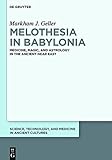Melothesia in Babylonia : medicine, magic, and astrology in the ancient Near East / Markham J. Geller.
Material type: TextSeries: Science, technology, and medicine in ancient cultures ; v. 2.Publisher: Boston : De Gruyter, [2014]Copyright date: ©2014Description: 1 online resource (xii, 100 pages .)Content type:
TextSeries: Science, technology, and medicine in ancient cultures ; v. 2.Publisher: Boston : De Gruyter, [2014]Copyright date: ©2014Description: 1 online resource (xii, 100 pages .)Content type: - 1614516936
- 9781614516934
- 9781614519348
- 161451934X
- Medicine, Assyro-Babylonian
- Astrology, Assyro-Babylonian
- Medical astrology
- Astrology
- Medicine -- History
- Magic
- History, Ancient
- Astrology
- History of Medicine
- Magic
- Mesopotamia
- Médecine assyro-babylonienne
- Astrologie assyro-babylonienne
- Astrologie médicale
- Astrologie
- Médecine -- Histoire
- Magie
- astrology
- history of medicine
- illusion (performing art)
- magic (occult science)
- TRAVEL -- South America -- General
- Medicine
- Magic
- Astrology
- Astrology, Assyro-Babylonian
- Medical astrology
- Medicine, Assyro-Babylonian
- 610.935 23
- R135.3 .G45 2014
- WZ 51
- online - EBSCO
| Item type | Current library | Call number | URL | Status | Notes | Barcode | |
|---|---|---|---|---|---|---|---|
 eBook
eBook
|
Biblioteca "Angelicum" Pont. Univ. S.Tommaso d'Aquino Nuvola online | online - EBSCO (Browse shelf(Opens below)) | Online access | Not for loan (Accesso limitato) | Accesso per gli utenti autorizzati / Access for authorized users | (ebsco)935389 |
Browsing Biblioteca "Angelicum" Pont. Univ. S.Tommaso d'Aquino shelves, Shelving location: Nuvola online Close shelf browser (Hides shelf browser)
Print version record.
Includes bibliographical references and index.
Introduction: globalisation of knowledge -- The Uruk taxonomy (SBTU I 43) -- Uruk astral magic (BRM 4 20 and BRM 4 19) -- The Neo-Assyrian precursor: before the zodiac -- Ancient Aramaic and Greek parallels -- Astrological interpretation of SBTU I 43 -- Melothesia -- Concluding hypothesis.
This book examines the Babylonian backgroundof melothesia, the science of charting zodiac influences on the human body, which transformed older divination by connecting astrology with medical techniques. Special attention is given to a text from late-5th-century Uruk, which is argued to be an important representative of this new approach to the healing arts, previously only known from Greek and medieval astrology.
In English.









